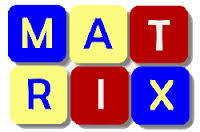An easy IIT-JEE problem
 Let
A
be the set of all 3 × 3 symmetric matrices all of whose entries are either 0 or 1. Five of these entries are 1 and four of them are 0.
Let
A
be the set of all 3 × 3 symmetric matrices all of whose entries are either 0 or 1. Five of these entries are 1 and four of them are 0.
The number of matrices in A is?
This section requires Javascript.
You are seeing this because something didn't load right. We suggest you, (a) try
refreshing the page, (b) enabling javascript if it is disabled on your browser and,
finally, (c)
loading the
non-javascript version of this page
. We're sorry about the hassle.
For the matrix A to be symmetric it must be equal to its transpose, i.e., the entries must be such that a i j = a j i .
For a 3 x 3 matrix this means that we require the 3 "pairings" a 1 2 = a 2 1 , a 1 3 = a 3 1 and a 2 3 = a 3 2 , while a 1 1 , a 2 2 and a 3 3 are unchanged by the transposing.
Now, 4 of the entries can be 0 (and the remaining entries 1 ), in the following ways:
(i) precisely one of the pairings can be composed of 0 's and two of the a i i entries can be 0 , or
(ii) precisely two of the pairings can be composed of 0 's, with all the remaining entires being 1 's.
Case (i) gives us ( 1 3 ) ( 2 3 ) = 9 possible matrices, and case (ii) gives us just ( 2 3 ) = 3 possible matrices.
Thus the total number of possible matrices that meet the given restrictions is 9 + 3 = 1 2 .